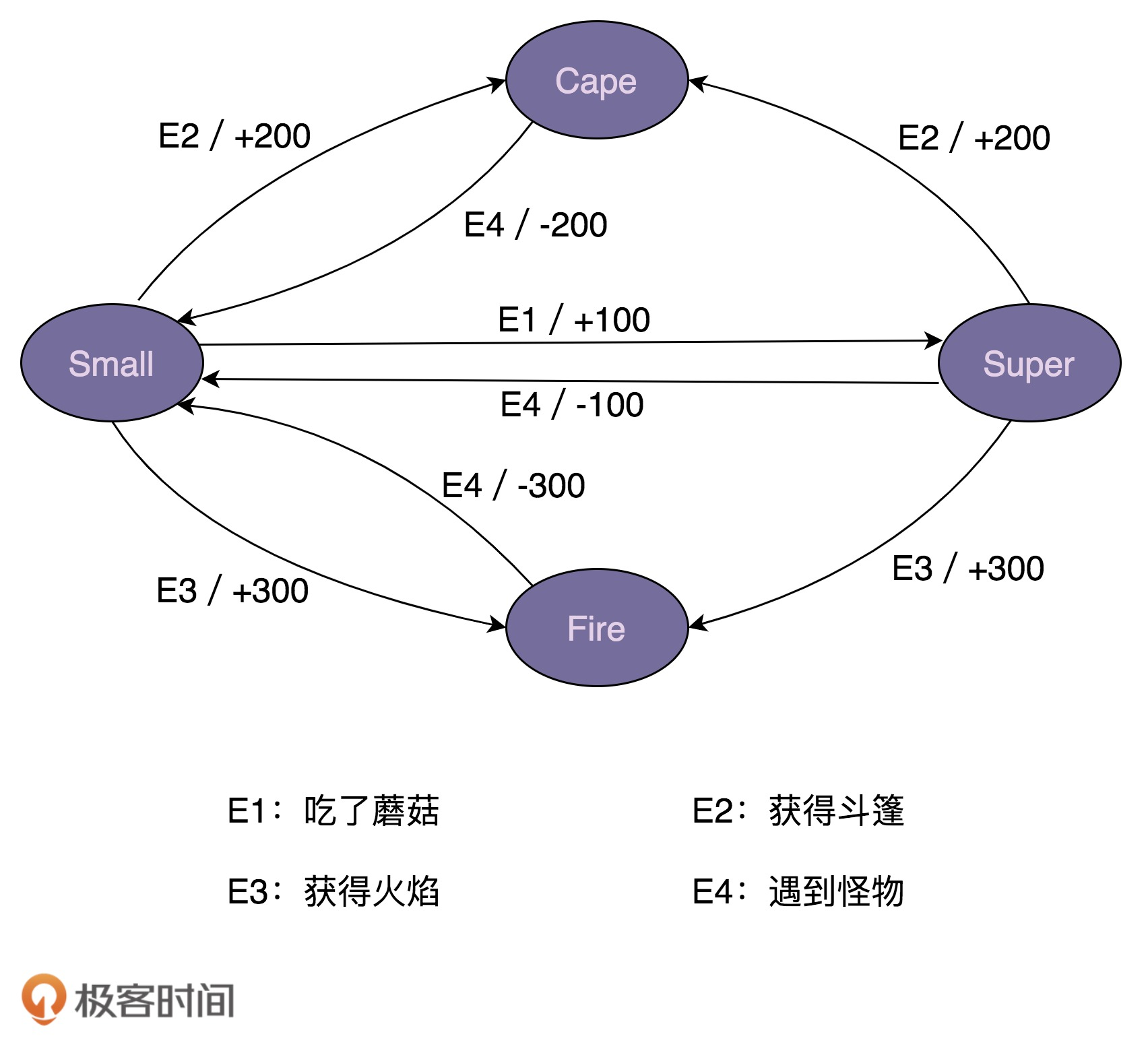状态模式一般用来实现状态机,而状态机常用在游戏、工作流引擎等系统开发中。
什么是有限状态机?
有限状态机,英文翻译是 Finite State Machine,缩写为 FSM,简称为状态机。状态机有 3 个组成部分:
- 状态(State)
- 事件(Event)也称为转移条件(Transition Condition)。事件触发状态的转移及动作的执行。不过,动作不是必须的,也可能只转移状态,不执行任何动作。
- 动作(Action)
形象的例子:
“超级马里奥”游戏不知道你玩过没有?在游戏中,马里奥可以变身为多种形态,比如小马里奥(Small Mario)、超级马里奥(Super Mario)、火焰马里奥(Fire Mario)、斗篷马里奥(Cape Mario)等等。在不同的游戏情节下,各个形态会互相转化,并相应的增减积分。比如,初始形态是小马里奥,吃了蘑菇之后就会变成超级马里奥,并且增加 100 积分。
其中,马里奥的不同形态就是状态机中的“状态”,游戏情节(比如吃了蘑菇)就是状态机中的“事件”,加减积分就是状态机中的“动作”。

public enum State {SMALL(0),SUPER(1),FIRE(2),CAPE(3);private int value;private State(int value) {this.value = value;}public int getValue() {return this.value;}}public class MarioStateMachine {private int score;private State currentState;public MarioStateMachine() {this.score = 0;this.currentState = State.SMALL;}// 各种事件public void obtainMushRoom() {//TODO}public void obtainCape() {//TODO}public void obtainFireFlower() {//TODO}public void meetMonster() {//TODO}public int getScore() {return this.score;}public State getCurrentState() {return this.currentState;}}public class ApplicationDemo {public static void main(String[] args) {MarioStateMachine mario = new MarioStateMachine();mario.obtainMushRoom(); // 触发事件int score = mario.getScore();State state = mario.getCurrentState();System.out.println("mario score: " + score + "; state: " + state);}}
状态机实现方式一:分支逻辑法
- 判断当前状态 (产生分支)
- 切换状态
public class MarioStateMachine {private int score;private State currentState;public MarioStateMachine() {this.score = 0;this.currentState = State.SMALL;}public void obtainMushRoom() {if (currentState.equals(State.SMALL)) {this.currentState = State.SUPER;this.score += 100;}}public void obtainCape() {if (currentState.equals(State.SMALL) || currentState.equals(State.SUPER) ) {this.currentState = State.CAPE;this.score += 200;}}public void obtainFireFlower() {if (currentState.equals(State.SMALL) || currentState.equals(State.SUPER) ) {this.currentState = State.FIRE;this.score += 300;}}public void meetMonster() {if (currentState.equals(State.SUPER)) {this.currentState = State.SMALL;this.score -= 100;return;}if (currentState.equals(State.CAPE)) {this.currentState = State.SMALL;this.score -= 200;return;}if (currentState.equals(State.FIRE)) {this.currentState = State.SMALL;this.score -= 300;return;}}public int getScore() {return this.score;}public State getCurrentState() {return this.currentState;}}
状态机实现方式二:查表法

public enum Event {GOT_MUSHROOM(0),GOT_CAPE(1),GOT_FIRE(2),MET_MONSTER(3);private int value;private Event(int value) {this.value = value;}public int getValue() {return this.value;}}public class MarioStateMachine {private int score;private State currentState;private static final State[][] transitionTable = {{SUPER, CAPE, FIRE, SMALL},{SUPER, CAPE, FIRE, SMALL},{CAPE, CAPE, CAPE, SMALL},{FIRE, FIRE, FIRE, SMALL}};private static final int[][] actionTable = {{+100, +200, +300, +0},{+0, +200, +300, -100},{+0, +0, +0, -200},{+0, +0, +0, -300}};public MarioStateMachine() {this.score = 0;this.currentState = State.SMALL;}public void obtainMushRoom() {executeEvent(Event.GOT_MUSHROOM);}public void obtainCape() {executeEvent(Event.GOT_CAPE);}public void obtainFireFlower() {executeEvent(Event.GOT_FIRE);}public void meetMonster() {executeEvent(Event.MET_MONSTER);}private void executeEvent(Event event) {int stateValue = currentState.getValue();int eventValue = event.getValue();this.currentState = transitionTable[stateValue][eventValue];this.score = actionTable[stateValue][eventValue]; // +=?}public int getScore() {return this.score;}public State getCurrentState() {return this.currentState;}}
状态机实现方式三:状态模式
MarioStateMachine 和各个状态类之间是双向依赖关系。MarioStateMachine 依赖各个状态类是理所当然的,但是,反过来,各个状态类为什么要依赖 MarioStateMachine 呢?这是因为,各个状态类需要更新 MarioStateMachine 中的两个变量,score 和 currentState。
public interface IMario { //所有状态类的接口State getName();//以下是定义的事件void obtainMushRoom();void obtainCape();void obtainFireFlower();void meetMonster();}public class SmallMario implements IMario {private MarioStateMachine stateMachine;public SmallMario(MarioStateMachine stateMachine) {this.stateMachine = stateMachine;}@Overridepublic State getName() {return State.SMALL;}@Overridepublic void obtainMushRoom() {stateMachine.setCurrentState(new SuperMario(stateMachine));stateMachine.setScore(stateMachine.getScore() + 100);}@Overridepublic void obtainCape() {stateMachine.setCurrentState(new CapeMario(stateMachine));stateMachine.setScore(stateMachine.getScore() + 200);}@Overridepublic void obtainFireFlower() {stateMachine.setCurrentState(new FireMario(stateMachine));stateMachine.setScore(stateMachine.getScore() + 300);}@Overridepublic void meetMonster() {// do nothing...}}public class SuperMario implements IMario {private MarioStateMachine stateMachine;public SuperMario(MarioStateMachine stateMachine) {this.stateMachine = stateMachine;}@Overridepublic State getName() {return State.SUPER;}@Overridepublic void obtainMushRoom() {// do nothing...}@Overridepublic void obtainCape() {stateMachine.setCurrentState(new CapeMario(stateMachine));stateMachine.setScore(stateMachine.getScore() + 200);}@Overridepublic void obtainFireFlower() {stateMachine.setCurrentState(new FireMario(stateMachine));stateMachine.setScore(stateMachine.getScore() + 300);}@Overridepublic void meetMonster() {stateMachine.setCurrentState(new SmallMario(stateMachine));stateMachine.setScore(stateMachine.getScore() - 100);}}// 省略CapeMario、FireMario类...public class MarioStateMachine {private int score;private IMario currentState; // 不再使用枚举来表示状态public MarioStateMachine() {this.score = 0;this.currentState = new SmallMario(this);}public void obtainMushRoom() {this.currentState.obtainMushRoom();}public void obtainCape() {this.currentState.obtainCape();}public void obtainFireFlower() {this.currentState.obtainFireFlower();}public void meetMonster() {this.currentState.meetMonster();}public int getScore() {return this.score;}public State getCurrentState() {return this.currentState.getName();}public void setScore(int score) {this.score = score;}public void setCurrentState(IMario currentState) {this.currentState = currentState;}}

